SECTION A (25 Marks)
Answer all the questions in this section
- Draw a section of the main scale and full Vernier scale that would give a reading of 3.07 cm (1 mark)
- Figure 1 shows a burette partly filled with a liquid. The liquid was initially at the level shown. If the 400 drops of the liquid each volume 0.015cm3 was removed from the burette, mark the new level of liquid in the burette (1 mark)
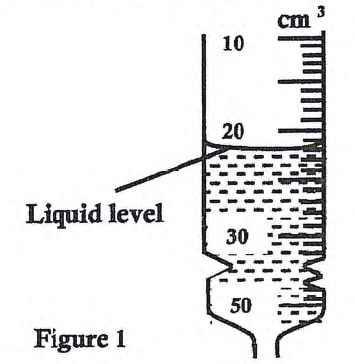
- A block of metal of mass 150g at 100oC is dropped into a lagged calorimeter of heat capacity 45 JK-1 containing 100g of water at 25oC. The temperature of the resulting mixture is 34oC. Determine the specific heat capacity of the metal block. (Take the specific heat capacity of water as 4,200 J/kgK) (3 marks)
- An object is placed on water and it floats. Write an equation connecting all the forces acting on the body. (1 mark)
- Figure 2 shows a 150 g mass tied on a string and whirled in a vertical circle of radius 30 cm with a uniform speed. At the lowest position of the circle the tension is 9.5 N. Calculate the speed v of the mass(3 marks)
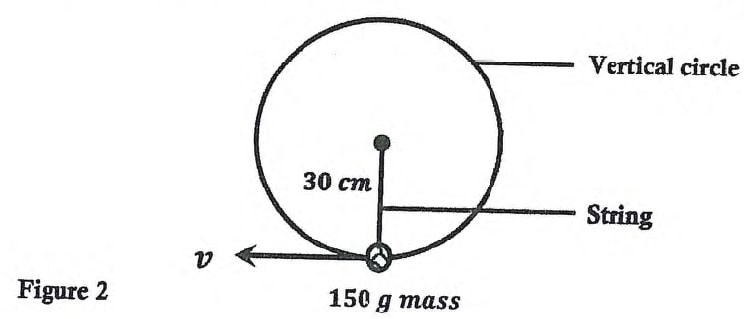
- Figure 3 shows two systems of spring arragements A and B. The springs are identical and have a spring constant K
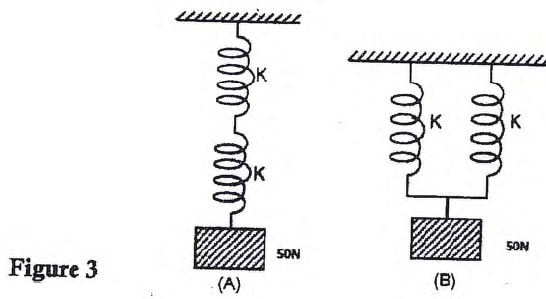
- State with a reason which system of springs is stiffer (2 marks)
- On the axes provided, sketch the graphs of systems A and B assuming that the springs obey Hooke's law
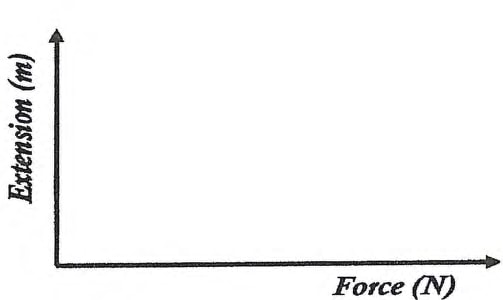
- Determine the value K if the extension in system B was 25 cm (2 marks)
- A piece of paper is wrapped round the joint of a rod partly made of iron and partly wood so that some of the paper is over the iron rod and the other part over the wooden rod as shown in Figure 4
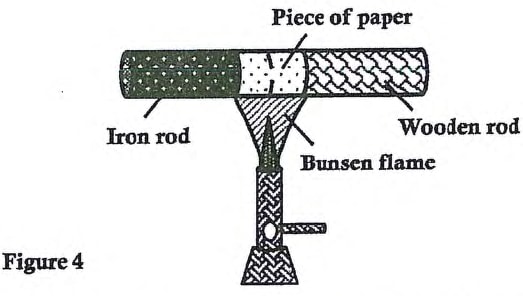
When a bunsen flame is passed over the paper several times it is observed that the paper gets charred or blacked on the region covering the wooden rod while the one covering the iron does not. Explain this observation made (2 marks) - A meter rule of mass 50 g is balanced by masses 35 g and 15 g suspened from its ends. Find the position of its pivot from 25g mass (3 marks)
Figure 5 shows a bunsen burner which is used for heating substances in a laboratory. Use the information given to answer Questions 9 and 10 below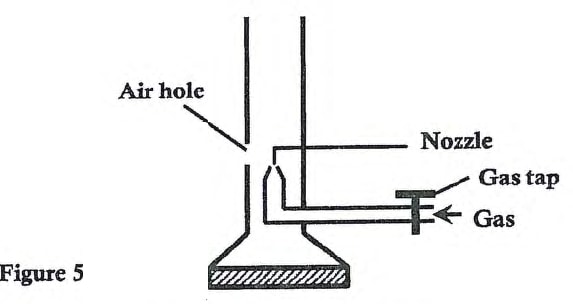
- Explain the principle of worklikng of a bunsnen burner (2 marks)
- Give a reason why the Bunsen burbner in the Figure 5 has a wide base (1 mark)
- Water rises up in capillary tubes but mercury which is also liquid, falls in capillary tubes to a level below the outside surafce as shown in Figure 6. Explain this observation. (2 marks)
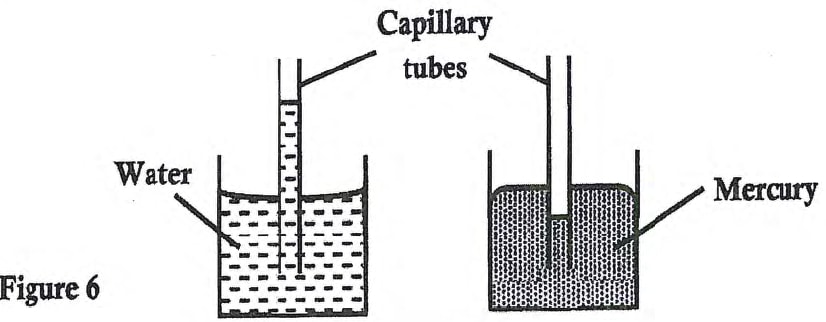
- State the molecular difference between a real gas and an ideal gas (1 mark)
SECTION B (55 Marks)
Answer all the questions in this section
-
- Figure 7 shows a car braking system. The brake fluid is an oily liquid
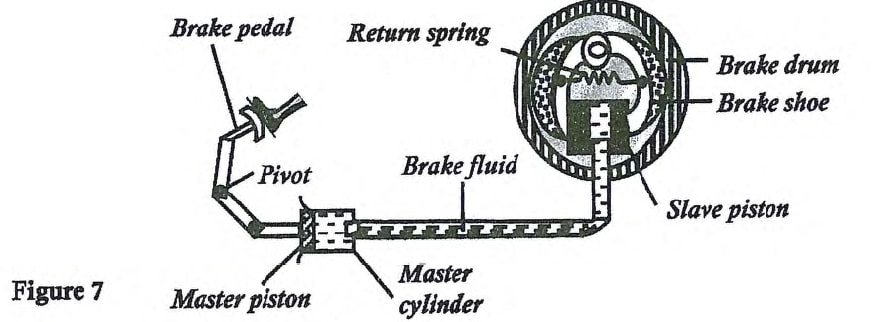
- State the principle by which a car braking system works (1 mark)
- State one property of the brake fluid used in this system (1 mark)
- The cross-sectioanl area of the master piston is 5.0cm2. A force of 1540 N is applied to the master psiton. Calculate the force exerted on each slave piston by the brake fluid given that the cross-sectional area of each slave psiton is 7.2 cm2 (3 marks)
- A diver is 15 m below the surface of water in a dam as shown in Figure 8
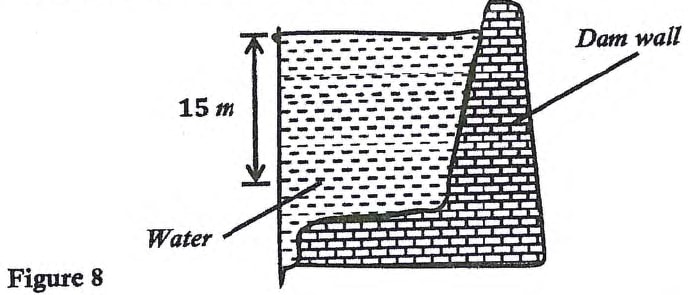
If the density of water is 1000 kg/m3 and gravity is 10N/kg, determine- The total pressure acting on the diver given that the atmospheric pressure at this place is 1.0 × 105 N/m2 (3 marks)
- Dam walls are made wider at the bottom than at the top. Explain (1 mark)
- Water in a measuring cylinder is placed in a refrigerator and allowed to cool from about 15oC to 0oC. Assuming the water does not freeze, sketch on the axes provided the graph of Volume of water against temperature (1 mark)
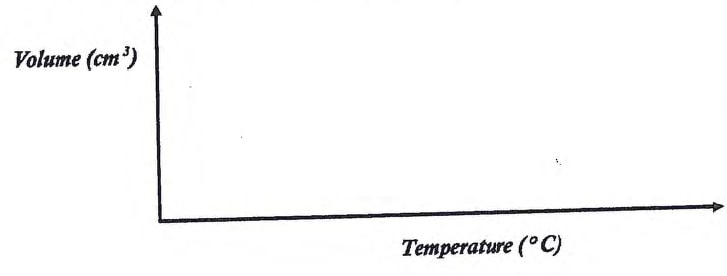
- Figure 9 shows a column of air trapped by mercury thread 5 cm long. If the atmospheric pressure is 750 mmHg, determine the length of the air column when the tube is horizontal (3 marks)
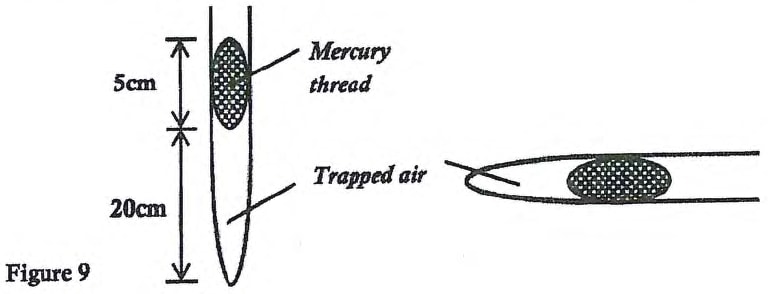
- Figure 7 shows a car braking system. The brake fluid is an oily liquid
-
- Figure 10 shows a car of mass m moving along a curved part of the road with a constant speed
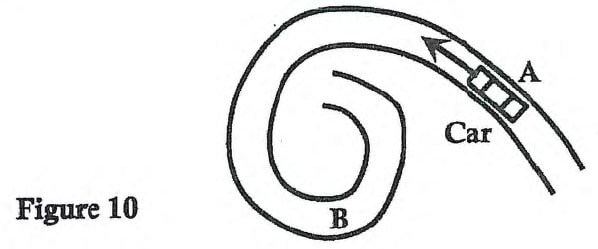
Explain why the car is more likely to skid at point B of the road if the speed is not changed (2 marks) - A particle P tied to a string is moving in a horizontal circle about O as shown in Figure 11. Particle P moves with a constant speed v

- State what provides the centripetal force. (1 mark)
- Use an arrow to indicate the direction in which the net force F acting on P will act (1 mark)
- Give a reason why particle P above experiences centripetal acceleration even thopugh it is moving with a constant speed v (1 mark)
- Figure 12 shows two masses 0.2 kg and 0.4 kg connected by a string through a hole on a smooth horizontal surface
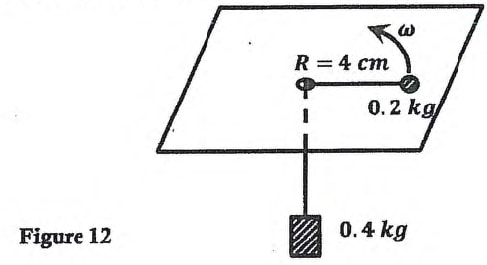
The 0.2 kg mass rotates in a horizontal circle of radius 4 cm. Calculate the angular velocity of the mass when the system is in equilibrium. Take acceleration due to gravity, g= 10 m/s2 (3 marks) - A jet starts from rest with a uniform acceleartion of 500 m/s2. how long does it take to cover a distance of 40 km? (3 marks)
- Figure 10 shows a car of mass m moving along a curved part of the road with a constant speed
-
- A horizontal force of 50 N is applied on a wooden block of mass 2.5 kg placed on a horizontal surface. Given that the coefficient of kinetic friction between the surface and the block is 0.5, determine the acceleration of the block (3 marks)
- Figure 13 shows a graph of velocity aginst time for a ball bearing released at the surface of a viscous liquid
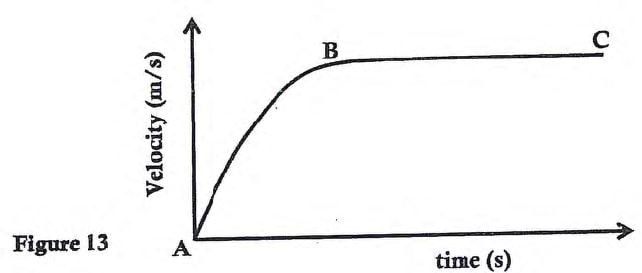
- Write an expression/equation connecting all the forces acting on the ball bearing parts
- AB (1 mark)
- BC (1 mark)
- Indicate on the graph the terminal velcoty Vt of the ball bearing (1 mark)
- Write an expression/equation connecting all the forces acting on the ball bearing parts
- Figure 14 shows a pulley system being used to lift a load of 150 N by applying an effort of 60N
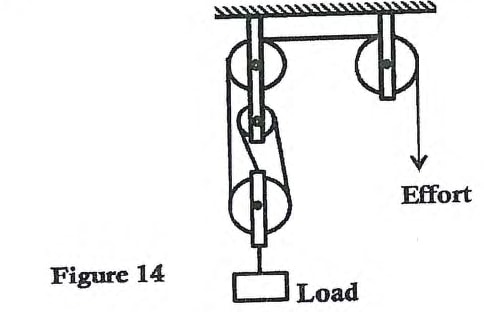
- State the velocity ratio of the pulley system (1 mark)
- Calculate the efficiency of the pulley system (4 marks)
- Show that the velocity ratio of a wheel and axle machine whose cross-section is shown in Figure 15 is given by V.R. =R/r where R is the radius of the wheel while r is the radius of the axle (2 marks)
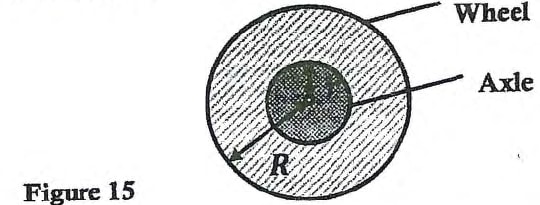
-
- Define the term "specific latent heat of fusion" of a material (1 mark)
- A metal bar of mass 30 g and specific heat capacity 880 J/kgK is placed in a small furnace. Figure 16 shows how the teperature of the metal bar varies with time t in seconds
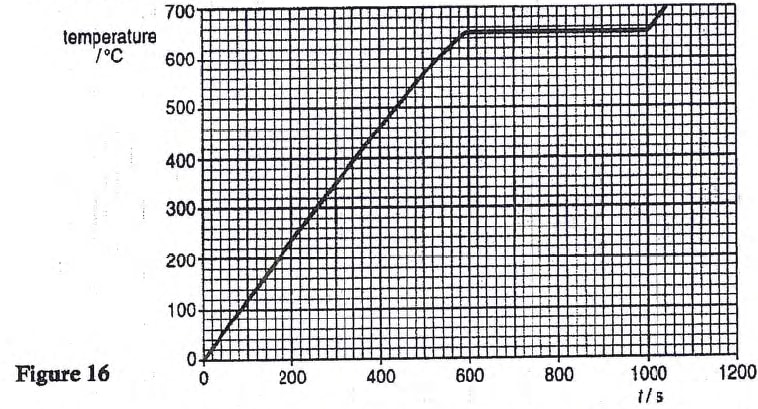
- State what happens to the bar betwen t = 600s and 1000s (1 mark)
- Calculate the energy supplied to the bar between t = 0s and 600s (3 marks)
- Between t = 600s and 1000s the furnace supplies 30 joules of energy per secodn to the bar. Calculate the specific latent heat of fusion oof the metal bar (3 marks)
-
- State Archimedes' principle (1 mark)
- The system in Figure 17 below is in equilibrium
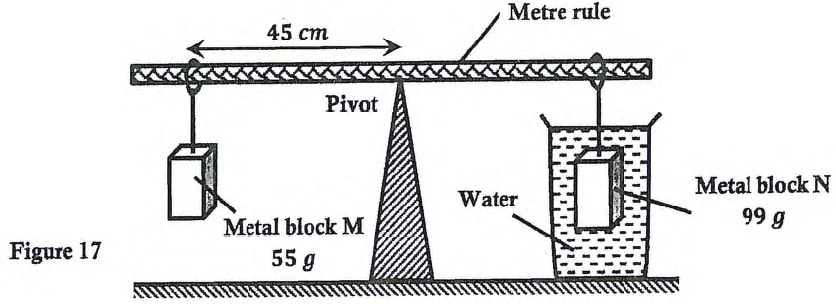
- When the temperature of the water is raised the system is observed to tilt to the right, state the reason for this observation (2 marks)
- Calculate the apparent loss of weight of the metal block N given the dimensions of the block are 2cm × 2cm × 6cm (3 marks)
- Determine the apparent weight of the metal block N (2 marks)
- How far is the metal block N from the pivot? (2 marks)
Download PHYSICS PAPER 1 - 2019 KCSE Prediction Questions Set 1.
Tap Here to Download for 50/-
Get on WhatsApp for 50/-
Why download?
- ✔ To read offline at any time.
- ✔ To Print at your convenience
- ✔ Share Easily with Friends / Students

